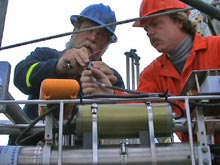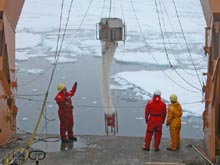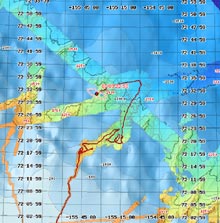
Dale re-engineers an electrical circuit on the camera sled. The electrical circuit will be used to trigger a strobe. Click image for larger view.
A Man Behind the Scenes…
July 4, 2005
Kelley Elliott
Web Coordinator
NOAA Office of Ocean Exploration
The multi-net and photo sled systems are up and working! Each scientist on board has brought a variety of equipment to take measurements, and collect samples to conduct research. What each scientist was not able to bring with them, however, was their technician. With more than 20 scientists on board and equipment from around the world, getting everything up and running, and ensuring it works properly on a 420-foot boat is not a simple task. Behind many unexpected technical problems the scientists have faced on board is Lamont Research Engineer, Dale Chayes.
During the first days of the cruise, scientists set up their equipment for its first deployment. Some of the equipment brought on board, however, needs additional connections to be remotely controlled from the boat and transfer data while it is deep in the ocean. The Healy's installed scientific equipment was all up and running before our science party came aboard. Some of the new instruments brought aboard for this cruise, however, need a bit of help.

An operational multi-net used to collect zooplankton samples from different depths in the water column is deployed! The multinet is lowered on a cable that also provides power and communication between scientists on board and the equipment deep in the ocean. Click image for larger view.
A multi-net to collect zooplankton samples from different depths in the water column, and a photo sled intended to take images of creatures at various depths both needed to be connected to the cable on which they would be lowered into the ocean. The cable connecting the equipment to the surface not only lowers the instrument, but also provides power and communication between scientists on board and equipment deep in the ocean. Dale worked with the Healy's Marine Science Technicians (MSTs) to create a mechanical and electrical connection on each end of the cable so the scientists could communicate with their equipment. He also re-engineered the electrical circuit to trigger a strobe light on the camera sled.
Dale has also played a role in helping configure the Remotely Operated Vehicle (ROV) brought on board. He re-programmed the Conductivity Temperature Depth (CTD) sensor on the ROV. The CTD is a sensor that measures conductivity (a measure of “saltiness” in the water), temperature and depth, to calculate the salinity of the water as well. Once sensors and equipment were up and working, he helped re-route the CTD data collected from the ROV into the Healy's data acquisition, a computer system that logs all the information and the time it was collected. Once the data is logged, he wrote a small computer program to display the data so the scientists and ROV operators could see it in real-time.
The Healy routinely operates a broad range of installed equipment with assistance from Dale's technical group. Many of these systems were installed when the ship was built and have been operating since 2000. At the start of each operating season, these systems are checked out during a “shakedown” cruise before scientists come aboard. Two students from the University of Hawaii are on board this cruise to be watch standers for collection of multibeam sonar data that they use to create 3-D images of the seafloor. When first coming on board the cruise they were happy to find that all the data they needed was already being collected and stored by systems on board the ship; these systems were set up by Dale's group and Healy crewmembers in 2000 and have been kept up-to-date since.

Multibeam image displaying sonar data collected by Healy's data acquisition system. The multibeam system was set up in 2000 and has been kept up-to-date by Dale's group and Healy crewmembers ever since. Click image for larger view.
Dale's job description includes a broad array of duties widely used on each scientific cruise. Having worked with scientific cruises since 1973, he has worked on many different ships and research platforms in different locations. He first sailed on the USCGC Healy in 2000, shortly after her departure from the shipyard to evaluate the multibeam sonar and it's supporting data system. His group has been supporting science equipment on the Healy seriously since 2003.
In addition to the specific technical support he directly provides scientists, Dale also trains the Marine Science Technicians (MST's), Electronic Technicians (ETs), and the rest of the Coast Guard crew how to operate, maintain and upgrade the science systems, to recognize good data, and how to communicate with the scientists on board. Although largely behind the scenes, he and his team play a key role to keeping current science operations on board going smoothly while working to keep systems updated and ready for future science operations.
Sign up for the Ocean Explorer E-mail Update List.
































